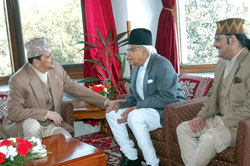|
|
| FATHER, SON AND THE HOLY GHOST: King Gyanendra (left), prince Paras (right) and Krishna Prasad Bhattarai at a lunch organised by the latter for his own 87th birthday. |
When the constituent assembly finally sits, making Nepal a republic is supposed to be the first item on its agenda, preceding even the work on drafting a new constitution.
The third amendment to the interim constitution in December 2007 declared Nepal a federal republic, but will only take effect when the measure is approved by the constituent assembly.
The move put the monarchy in suspended animation and removed him as the head of state, stripped him even of his ceremonial role, his command over the army and immunity from prosecution.
"At present, the monarchy is suspended monarchy," explains political science professor, Krishna Khanal, "the assembly of elected members will simply fulfil the formality of the king's honourable exit so he can become a commoner."
The promise to abolish the monarchy was initially considered a carrot to cajole the Maoists back into government last year, but there is now a consensus on republic among the seven party alliance. "It is not possible for the parties to make a u-turn," Khanal said.
Not everyone is so sure. Monarchists argue that the abolition of the monarchy and turning Nepal secular was taken by an unelected interim house and is therefore illegitimate. They have demanded either a referendum or for the constituent assembly to decide on such a momentous decision.
Rabindra Sharma of the royalist RPP (Nepal) says: "Throughout history monarchies have been abolished either through revolution or referendum. But these parties will not accept a referendum because they know people still believe in the monarchy. The interim parliament cannot decide the fate of the monarchy and the third amendment was unconstitutional."
Sharma says that monarchy is an essential symbol of national identity and that the NC and UML have only adopted a republican agenda under pressure from the Maoists. "I do not believe those two parties are really republican," he says.
Indeed, the most recent public opinion polls by Inter-disciplinary Analysts (IDA) in January showed that as much as 49 percent of the respondents wanted to retain a symbolic monarchy and 65 percent were against secularlism. ( 'Pre-poll poll', #386)
However, Gyanendra's popularity is very low and few respondents want him to remain king. If the royalist parties have a strong showing in elections the assembly may find it difficult to ignore public opinion.
Khanal believes the bill on abolition of the monarchy will be passed with a full majority. But there are three wild cards: the Nepal Army, the anti-secular groups in Nepal and India, and the monarchists within the mainstream parties.
After the legislation goes through parliament, the king will probably be served notice to vacate the palace. He is not expected to resist.
"Any move against the assembly will not only be unconstitutional but also anti-people this time," says Khanal.
After that question is out of the way, the parties are expected to be mired in debate about whether to adopt a prime ministerial or presidential system, and whether to have regional or ethnic federalism.
Nepal Bar Association president, Bishwakanta Mainali doesn't expect much debate on the republic within the house. "There will be royalists in the assembly, but they will be too few to get a constitutional monarchy through," he predicts.
RPP (Nepal) is the only party out of 54 favouring a constitutional monarchy. RPP and the Rastriya Janasakti Party are fence-sitting.
For his part, king Gyanendra has taken note of the poll results. He told the Japanese newspaper Yomuiri Shimbun in his last interview in February that the assembly would not be reflecting the view of a majority of Nepalis if it abolished the monarchy. "Most people find great meaning in the institution of the monarchy. Every cloud has a silver lining. Let us hope," he had said.
However, unless there is either a spontaneous uprising in support of the monarchy or a military coup, it does look like the sun is setting on the Shah dynasty that forged Nepal and ruled it for 239 years.



